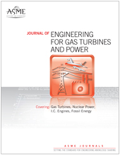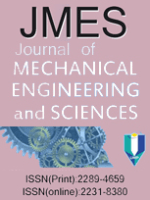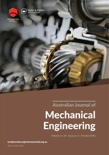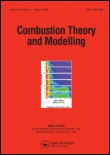
JOURNAL OF ENGINEERING FOR GAS TURBINES AND POWER-TRANSACTIONS OF THE ASME
Scope & Guideline
Powering Innovation in Gas Turbines and Beyond
Introduction
Aims and Scopes
- Gas Turbine Design and Optimization:
Research related to the design and optimization of gas turbine systems, including aerodynamic design, thermal management, and component interactions to enhance efficiency and reduce emissions. - Combustion Dynamics and Emissions Control:
Studies focused on combustion processes, including the investigation of fuel types, combustion stability, and emissions reduction technologies to meet regulatory standards. - Fluid Dynamics and Heat Transfer:
Exploration of fluid dynamics and heat transfer phenomena in various components of gas turbine systems, utilizing computational fluid dynamics (CFD) and experimental validation. - Vibration and Structural Dynamics:
Analysis of vibration characteristics, structural dynamics, and health monitoring of turbine components using advanced modeling techniques and experimental methods. - Advanced Manufacturing Techniques:
Innovations in manufacturing processes such as additive manufacturing and their implications for the performance and durability of gas turbine components. - Hybrid and Renewable Energy Systems:
Integration of gas turbine technology with renewable energy systems, focusing on hybrid and microgrid applications to enhance energy sustainability. - Machine Learning and Data Analytics:
Application of machine learning and data analytics in predictive maintenance, performance monitoring, and optimization of gas turbine operations.
Trending and Emerging
- Hydrogen and Alternative Fuels:
Research focusing on the use of hydrogen and other alternative fuels in gas turbines is increasing, driven by the need for decarbonization and sustainability in energy production. - Advanced Computational Modeling:
There is a significant trend towards sophisticated computational modeling techniques, including machine learning and AI applications, to enhance predictive capabilities in turbine design and operation. - Thermal and Fluid Management Innovations:
Emerging studies are increasingly centered on innovative thermal management systems and fluid dynamics techniques that improve efficiency and performance under varying operational conditions. - Integrated Energy Systems:
Research on integrated systems combining gas turbines with renewable energy sources and energy storage solutions is gaining traction, reflecting a shift towards more holistic energy management approaches. - Real-Time Monitoring and Predictive Maintenance:
The application of real-time monitoring techniques and predictive maintenance strategies is on the rise, utilizing data analytics to enhance operational reliability and efficiency.
Declining or Waning
- Conventional Fossil Fuel Technologies:
Research related to traditional fossil fuel-based gas turbine technologies is diminishing as the industry increasingly shifts towards cleaner, more sustainable energy solutions. - Simple Combustion Models:
The use of basic combustion models is waning in favor of more complex, detailed simulations that incorporate advanced chemistry and turbulence modeling to better predict combustion behavior. - Static Performance Testing:
Static performance assessments are becoming less common as dynamic, real-time testing methodologies gain traction, reflecting a need for more realistic operational data. - Traditional Control Strategies:
Conventional control strategies for gas turbine operation are being overshadowed by more innovative, adaptive, and AI-driven control methodologies that optimize performance in real-time.
Similar Journals

International Journal of Heavy Vehicle Systems
Exploring the Future of Automotive EngineeringThe International Journal of Heavy Vehicle Systems, published by INDERSCIENCE ENTERPRISES LTD in the United Kingdom, is a pivotal resource for professionals and researchers in the fields of automotive and mechanical engineering. With an ISSN of 1744-232X and an E-ISSN of 1741-5152, this journal serves as an academic platform dedicated to exploring the latest innovations and technologies pertaining to heavy vehicle systems, including design, performance, and environmental impact. Boasting a Category Quartile of Q3 in both Automotive and Mechanical Engineering as of 2023, it ranks among the growing body of literature in these disciplines, indicative of its commitment to quality research. The journal is widely accessible through diverse open access options, encouraging the dissemination of knowledge within the academic community. By publishing cutting-edge studies and reviews, the International Journal of Heavy Vehicle Systems plays an essential role in advancing our understanding of heavy vehicle technologies, providing invaluable insight for engineers, researchers, and students eager to contribute to this dynamic field.

FDMP-Fluid Dynamics & Materials Processing
Exploring the Nexus of Fluid Dynamics and Material InnovationFDMP-Fluid Dynamics & Materials Processing, published by TECH SCIENCE PRESS, stands as a significant contribution to the field of materials science, specifically focusing on the intricate relationships between fluid dynamics and material processing. With an ISSN of 1555-256X and an E-ISSN of 1555-2578, this journal offers an open-access platform where researchers can disseminate their work broadly, promoting collaboration and innovation among professionals and students alike. Established in 2007 and continuously evolving through to 2024, the journal is classified in the Q4 category of materials science, ranking at #347 out of 463 in the Scopus database, signifying its niche yet crucial role in the academic community. By focusing on the dynamic interplay between fluid behavior and material properties, FDMP addresses contemporary challenges and advances in material processing techniques. The journal plays a pivotal role for academics and industry professionals seeking to push the boundaries of knowledge and application in materials science.

Journal of Mechanical Engineering and Sciences
Exploring New Horizons in Mechanical SciencesThe Journal of Mechanical Engineering and Sciences (ISSN: 2289-4659, E-ISSN: 2231-8380), published by UNIV MALAYSIA PAHANG, is a prominent open access journal established in 2011, dedicated to advancing the field of mechanical engineering and associated sciences. Covering a wide array of topics from industrial manufacturing processes to computational mechanics, the journal serves as a vital platform for researchers, professionals, and students to disseminate innovative findings and methodologies. With impressive Scopus rankings, including a place in the 60th percentile for Industrial and Manufacturing Engineering, the journal holds a significant position among its peers, facilitating global academic discourse. Located in Kuantan, Pahang, Malaysia, the journal emphasizes accessibility and collaboration within the engineering community, encouraging submissions that contribute to both theoretical and applied aspects of mechanical engineering.

THERMAL ENGINEERING
Driving Excellence in Thermal Engineering ResearchTHERMAL ENGINEERING is a premier journal dedicated to advancing the field of thermal engineering, with particular importance in the domains of Energy Engineering, Nuclear Energy, and Power Technology. Published by PLEIADES PUBLISHING INC, this esteemed journal has been providing significant scholarly contributions since its inception, with its converged years spanning from 1970 to 2024. Though currently non-open access, the journal presents a unique avenue for researchers, professionals, and students to explore groundbreaking research and innovative solutions related to energy systems and thermal processes. With a notable impact factor and positioned in the Q3 quartile for both Energy Engineering and Nuclear Energy, THERMAL ENGINEERING ensures the dissemination of high-quality research with a global reach, making it an essential resource for those looking to stay at the forefront of essential energy technologies and engineering advancements.

STROJNISKI VESTNIK-JOURNAL OF MECHANICAL ENGINEERING
Unveiling Cutting-Edge Discoveries in Mechanical EngineeringSTROJNISKI VESTNIK-JOURNAL OF MECHANICAL ENGINEERING is a prestigious publication that has been disseminating cutting-edge research in the field of mechanical engineering since 1974. Published by the Association of Mechanical Engineers Technicians Slovenia, this journal serves as a critical platform for professionals, researchers, and students aiming to explore advancements in mechanical engineering and mechanics of materials. With a category ranking in the Q3 quartile for both Mechanical Engineering and Mechanics of Materials, the journal reflects a robust engagement with contemporary research and practices, contributing to the ongoing discourse within these vital disciplines. Although currently not open access, the journal is committed to providing high-quality, peer-reviewed articles that facilitate knowledge sharing and innovation. It is indexed in Scopus, maintaining respectable standings within its categories, thereby underlining its importance and impact in the global academic community.

Australian Journal of Mechanical Engineering
Advancing Mechanical Engineering Knowledge for Tomorrow's Innovations.The Australian Journal of Mechanical Engineering is a distinguished publication in the realm of mechanical engineering, dedicated to advancing the knowledge and application of engineering principles within the industry. Published by TAYLOR & FRANCIS LTD in the United Kingdom, this journal has been integral to the field since its inception, featuring a range of peer-reviewed research articles, reviews, and technical notes that collectively aim to bridge theoretical research with practical applications. With an impressive Scopus ranking of #271 out of 672 in Mechanical Engineering, positioning it within the 59th percentile, the journal continues to uphold rigorous academic standards, currently occupying Q3 in the 2023 quartile rankings. Researchers, professionals, and students alike will benefit from its comprehensive coverage and insightful contributions, providing a vital platform for knowledge exchange and innovation in mechanical engineering.

International Journal of Turbomachinery Propulsion and Power
Advancing the frontiers of turbomachinery and propulsion.The International Journal of Turbomachinery Propulsion and Power, published by MDPI, is a pivotal scholarly platform devoted to advancing the field of turbomachinery, propulsion technology, and power systems. Since its inception in 2016, this open-access journal has provided an invaluable resource for researchers, professionals, and students within the realms of Aerospace Engineering, Energy Engineering, and Mechanical Engineering. With its current ranking in the Q3 category across these disciplines and its strategic placement in Scopus, the journal facilitates the dissemination of cutting-edge research findings and innovative solutions. The commitment to open access, effective from 2017, ensures that high-quality research is readily accessible, fostering collaboration and knowledge sharing in the global academic community. As it continues to expand its scope through 2024, the journal remains a crucial avenue for discussion, experimentation, and advancement in turbomachinery and energy-related studies.

Journal of Naval Architecture and Marine Engineering
Transforming Marine Engineering Through Open AccessJournal of Naval Architecture and Marine Engineering is a distinguished open-access journal dedicated to advancing the field of marine engineering and naval architecture. Published by the ASSOCIATION OF NAVAL ARCHITECTS & MARINE ENGINEERING in Bangladesh, this journal has been a crucial platform for the dissemination of innovative research and practical applications since its transition to open access in 2007. With an impressive Q2 ranking in Ocean Engineering and a well-respected position within the Scopus rankings, it serves a vital role in connecting researchers and industry professionals. Covering a wide scope of topics from hydrodynamics to ship design and marine environmental protection, the journal invites contributions that enhance the knowledge and technology within the maritime sector. Accessed by a global audience, it is an essential resource for those seeking to make significant advancements in naval engineering.

Journal of the Global Power and Propulsion Society
Championing Excellence in Propulsion ResearchJournal of the Global Power and Propulsion Society, published by GLOBAL POWER PROPULSION SOC, is a premier open-access journal established in 2017, dedicated to the dissemination of innovative research and advancements in the fields of aerospace engineering, industrial and manufacturing engineering, and mechanical engineering. Based in Zug, Switzerland, this journal provides a critical platform for researchers, professionals, and students to engage with cutting-edge studies and emerging technologies that are pivotal to the aerospace and propulsion sectors. With an impressive categorization in the Q2 quartile for multiple engineering specialties in 2023, the journal reflects its commitment to quality and rigor in its peer-reviewed articles. Moreover, it holds substantial visibility in the academic community, as evidenced by its Scopus rankings. The Journal of the Global Power and Propulsion Society stands at the intersection of innovation and collaboration, aiming to foster knowledge sharing globally while enhancing the operational capabilities of power and propulsion technologies.

COMBUSTION THEORY AND MODELLING
Exploring the Dynamics of Combustion ProcessesCombustion Theory and Modelling is a pivotal journal for researchers and professionals in the fields of chemical engineering, energy technology, and combustion science. Published by Taylor & Francis Ltd, this journal, with an ISSN of 1364-7830 and E-ISSN 1741-3559, provides a platform for disseminating significant advances in our understanding of combustion processes and their applications. With a solid impact factor, as reflected in its Q2 ranking across multiple categories including Chemical Engineering, Energy Engineering, and Modeling and Simulation, it serves not only to enhance theoretical knowledge but also to bridge the gap between theory and practical applications. The journal spans a wide timeline from 1997 to 2024, ensuring that it covers both foundational studies and cutting-edge research. Situated in the UK, the journal actively invites submissions that contribute to the evolving landscape of combustion science, making it an essential resource for academics, industry professionals, and students keen on exploring the dynamics of energy and fuel technologies.